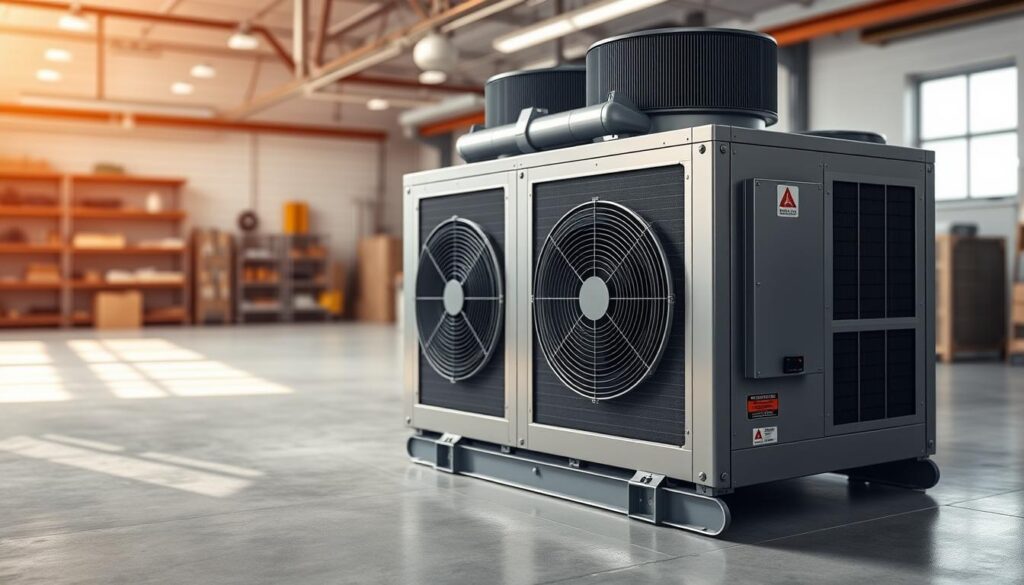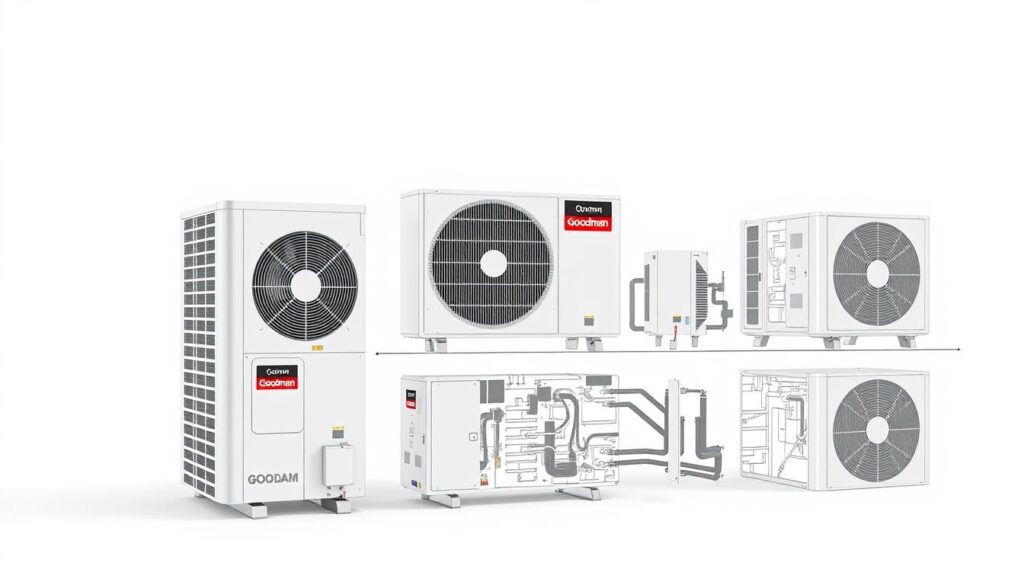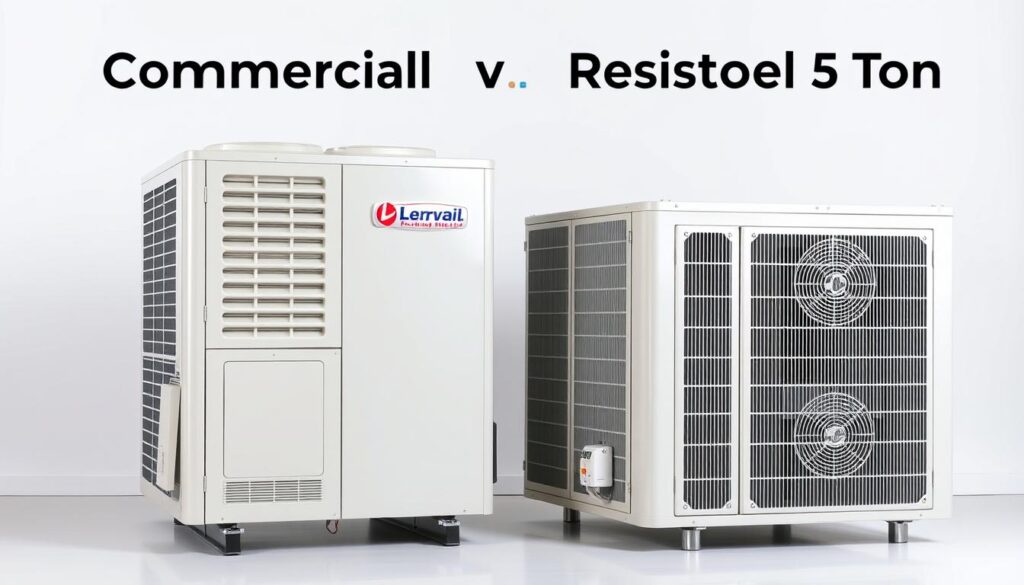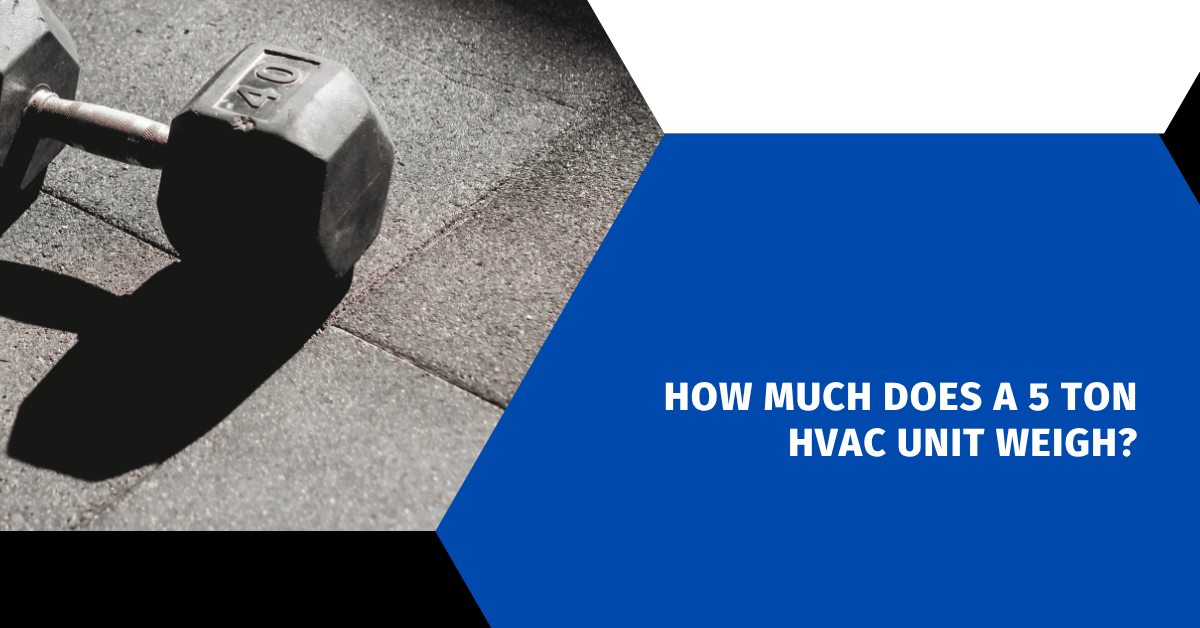Affiliate Disclosure
HVAC Guide Guys is a participant in the Amazon Services LLC Associates Program, an affiliate advertising program designed to provide a means for sites to earn advertising fees by advertising and linking to Amazon.
How Much Does a 5 Ton HVAC Unit Weigh? Ever thought about the weight of your home’s cooling system? Knowing the weight of a 5 ton HVAC unit is key. It affects installation, moving it, and how well it works over time.

Thinking about the weight of a 5 ton HVAC unit is more than just numbers. It changes everything from how strong your house needs to be to how well it uses energy. Both pros and homeowners must see how important these big systems are.
Your HVAC system is a big investment. Knowing its weight helps you make smart choices about where to put it, how to support it, and how to keep it running well. Whether you’re setting up a new system or replacing an old one, understanding weight is vital.
Key Takeaways
- A 5 ton HVAC unit’s weight varies significantly between indoor and outdoor components
- Weight impacts installation, transportation, and structural requirements
- Professional assessment is critical for proper HVAC unit placement
- Material composition affects overall system weight
- Weight considerations are key for long-term system performance
Table of Contents
Understanding 5 Ton HVAC Units and Their Physical Properties
The 5 ton ac unit is a strong choice for keeping your home cool. It’s a big investment in comfort and saving energy.
A 5 ton HVAC unit can cool your space by removing about 60,000 BTUs of heat per hour. It’s perfect for big homes or places that get really hot.
Basic Components of a 5 Ton Unit
The main parts of a 5 ton central air conditioner are:
- Compressor: The heart of the cooling system
- Condenser coils: Responsible for heat exchange
- Evaporator coils: Absorb indoor heat
- Refrigerant lines: Transport cooling agents
- Electrical controls: Manage system operations
Weight Distribution Factors
Several things affect how a 5 ton cooling system is weighted:
- Compressor weight and placement
- Material quality of internal components
- Cabinet construction
- Refrigerant type and quantity
Size and Dimensions Overview
5 ton units are usually 30-36 inches tall and wide. They are 24-30 inches deep. Sizes can vary a bit between brands, but they fit well in most homes.
Standard Weight Ranges for 5 Ton AC Units
When you’re getting ready to install your air conditioning, knowing the weight of 5 ton AC units is key. These units can vary in weight based on the design and cooling needs of the manufacturer.
5 ton AC units usually have a certain weight range. This range can affect how easy it is to install them. Both homeowners and HVAC experts need to be aware of these typical weights:
- Indoor unit weight: 150-250 pounds
- Outdoor unit weight: 250-350 pounds
- Combined system weight: 400-600 pounds
The weight of your AC unit depends on a few important things:
- Material composition of internal parts
- How much cooling you need
- Any extra features or tech
- The design from the manufacturer
Different makers might have slightly different weights for their units. This can change how you move, mount, and install them. When picking a 5 ton AC unit, think about the weight, cooling power, and how it fits your space.
Pro tip: Always talk to a pro HVAC tech. They can help make sure your chosen unit fits your cooling needs and building structure.
Explore Our HVAC Shop
Looking for top-rated HVAC tools, parts, and accessories? Visit our shop and find the perfect solution for your needs.
Visit the ShopHow Much Does a 5 Ton HVAC Unit Weigh?
Knowing the weight of HVAC equipment is key for safe installation and upkeep. A 5 ton HVAC unit is a big piece of equipment. It has a lot of weight, which is important for homeowners and installers.
Looking into the weight of a 5 ton HVAC unit, you’ll see it’s made of many parts. Each part has its own weight.
Indoor Unit Weight Specifications
Indoor units, like air handlers or furnaces, are a big part of the system’s weight. They can weigh between 100-300 pounds. This depends on their design and materials.
- Air handler weight: 120-250 pounds
- Furnace weight: 100-300 pounds
- Materials impact weight variations
Outdoor Unit Weight Details
Outdoor condensing units for 5 ton systems are heavier. They usually weigh between 250-400 pounds. This is based on the equipment’s specifications.
| Manufacturer | Outdoor Unit Weight | Material Composition |
|---|---|---|
| Carrier | 310-375 pounds | Aluminum/Steel |
| Trane | 290-350 pounds | Galvanized Steel |
| Lennox | 270-340 pounds | Copper/Aluminum |
Combined System Weight
To find the total system weight, add the indoor and outdoor unit weights. A 5 ton HVAC system usually weighs 500-700 pounds. This makes professional installation very important.
Getting a professional to assess your property is vital. They ensure your property can handle the weight of this equipment safely and well.
Weight Variations Among Different Manufacturers
Looking into HVAC equipment specs, you’ll see 5-ton units weigh differently by brand. This is due to design, materials, and extra features that add to the weight.
To understand the hvac sizing guide, we must examine how brands build their units. Big names like Carrier, Trane, Lennox, and Goodman each have their own way of making 5-ton HVAC units.
| Manufacturer | Average Unit Weight | Key Construction Features |
|---|---|---|
| Carrier | 320-350 lbs | Aluminum coil, lightweight chassis |
| Trane | 340-370 lbs | Robust steel frame, enhanced durability |
| Lennox | 330-360 lbs | Precision-engineered components |
| Goodman | 310-340 lbs | Cost-effective design, lightweight materials |
Several factors affect the weight:
- Material quality
- Compressor design
- Coil construction
- Additional technological features
When picking an HVAC system, weight is not the only thing to think about. Performance, efficiency, and reliability are also key. Always talk to a pro to find the right unit for you.
Explore Our HVAC Shop
Looking for top-rated HVAC tools, parts, and accessories? Visit our shop and find the perfect solution for your needs.
Visit the ShopInstallation Weight Considerations
When planning to install a 5-ton HVAC unit, knowing its weight is key. HVAC contractors must look at many factors. This ensures the heavy cooling system is placed safely and works well.
- Structural integrity assessment
- Load-bearing capabilities
- Transportation logistics
- Equipment positioning strategies
Roof Load Requirements
Installing HVAC on the roof requires a detailed check. The roof must handle the weight without weakening. HVAC experts usually suggest:
- Comprehensive structural engineering analysis
- Reinforcement of mounting points
- Precise weight distribution calculations
Foundation Support Needs
For installations on the ground, careful planning is needed. Important factors include:
| Support Element | Recommended Specification |
|---|---|
| Concrete pad thickness | 4-6 inches minimum |
| Pad reinforcement | Rebar or wire mesh |
| Level surface tolerance | Maximum 1/4 inch variance |
Transportation Requirements
Moving a 5-ton HVAC unit needs special tools and skills. Your installation team should use:
- Heavy-duty transportation vehicles
- Professional lifting equipment
- Skilled technicians trained in equipment handling
Professional HVAC contractors know how to handle these weight issues. They ensure a safe and efficient installation. This protects your equipment and property.
Goodman 5 Ton Unit Specifications
The Goodman 5 ton unit is a top choice for cooling homes and small businesses. It’s known for its strong performance and well-designed parts.

This unit has advanced features that make it efficient and long-lasting. Key specs include:
- 14.3 SEER2 energy efficiency rating
- Single-stage compressor technology
- Copper tube aluminum fin condensing coil
- Heavy-gauge galvanized-steel cabinet
Its design is key to its success. The copper coil tubing with enhanced aluminum fins boosts heat transfer. This ensures it cools well.
| Specification | Details |
|---|---|
| Cooling Capacity | 5 Tons (60,000 BTU/hour) |
| Energy Efficiency | 14.3 SEER2 |
| Compressor Type | Single-Stage |
| Refrigerant | R-410A |
“Reliability meets efficiency in the Goodman 5 ton HVAC system” – HVAC Industry Experts
Knowing these specs helps you choose the right cooling system. The Goodman unit is a smart choice for comfort and saving energy.
Explore Our HVAC Shop
Looking for top-rated HVAC tools, parts, and accessories? Visit our shop and find the perfect solution for your needs.
Visit the ShopHVAC Unit Weight Impact on Energy Efficiency
Understanding how an HVAC unit’s weight affects its performance is key. The weight of your cooling equipment is vital for energy efficiency and reliability.
The weight of your HVAC system impacts its cooling power and how well it works. Several factors are at play:
- Material density and quality
- Structural integrity of components
- Thermal conductivity of materials
- Manufacturing precision
Relationship Between Weight and Performance
Heavier HVAC units usually mean better build and materials. Top-notch residential cooling systems have denser parts. These parts last longer and work more efficiently.
| Weight Factor | Performance Impact | Energy Efficiency Rating |
|---|---|---|
| Lightweight Components | Lower thermal stability | Moderate (80-85%) |
| Medium-Weight Components | Balanced performance | High (86-90%) |
| Heavy-Duty Components | Superior thermal management | Premium (91-95%) |
Material Quality Factors
Materials like high-density aluminum and reinforced composites help make cooling systems lighter and more efficient. These advancements let manufacturers boost cooling power without adding too much weight.
When picking an HVAC unit, think about the balance between weight, material quality, and energy performance. This will help you choose a cooling system that’s efficient and reliable in the long run.
Modern HVAC Technology and Weight Reduction
The world of central air conditioner technology is changing fast. Companies are working hard to make HVAC systems lighter without losing performance. These new ideas are changing how we think about cooling our homes.
Modern HVAC technologies focus on three main areas for weight reduction:
- Advanced lightweight materials
- Compact design strategies
- Modular system configurations
New materials like lightweight aluminum and composites are replacing old heavy metals. These materials are strong but don’t add much weight to air conditioners. Companies are making ultra-lightweight parts that cut down the system’s weight a lot.
| Technology | Weight Reduction | Performance Impact |
|---|---|---|
| Composite Materials | 15-25% lighter | Equivalent cooling capacity |
| Modular Design | 10-20% weight decrease | Improved installation flexibility |
| Advanced Aluminum Alloys | 12-18% weight reduction | Enhanced heat transfer efficiency |
These new technologies bring more than just lighter systems. They make installation easier, save on shipping costs, and use less energy. You’ll get systems that cool well and don’t take up much space.
Explore Our HVAC Shop
Looking for top-rated HVAC tools, parts, and accessories? Visit our shop and find the perfect solution for your needs.
Visit the ShopCommercial vs Residential 5 Ton Units

Choosing a 5 ton ac unit means knowing the difference between commercial and residential systems. Your HVAC guide should highlight these distinctions. Both types have the same cooling power but differ in many ways.
Commercial 5 ton ac units are built to last, for constant use in tough places. They focus on lasting performance, not looks. The main differences are:
- Heavier structural components
- More industrial-grade materials
- Enhanced cooling capabilities
- Larger footprint and weight
Residential 5 ton ac units aim for quiet operation and fit well in homes. They are designed to cool efficiently without taking up too much space.
| Feature | Commercial Unit | Residential Unit |
|---|---|---|
| Average Weight | 600-800 lbs | 350-500 lbs |
| Noise Level | 70-80 decibels | 50-60 decibels |
| Installation Complexity | High | Moderate |
What you need will decide which 5 ton ac unit is right for you. Think about space, how you’ll use it, and how long it will last.
Maintenance Considerations Based on Unit Weight
Maintaining a 5-ton HVAC unit is a big job. It needs careful planning and the right hvac contractor services. The unit’s heavy weight makes installation and upkeep tricky.
It’s important for property owners to understand the maintenance needs of heavy HVAC systems. The unit’s weight affects several key areas:
- Technician accessibility
- Required equipment for servicing
- Component replacement complexity
- Safety protocols during maintenance
Service Access Requirements
Heavy HVAC units need special service access. Technicians must have:
- Enough space around the unit
- Special lifting tools
- More people for safe handling
Component Replacement Challenges
Replacing parts in a 5-ton unit is hard. Weight distribution and structural integrity are key during maintenance.
| Maintenance Aspect | Challenges | Solution |
|---|---|---|
| Compressor Replacement | High weight, complex removal | Crane or specialized lifting mechanism |
| Coil Servicing | Limited access points | Modular design with removable panels |
| Electrical Component Work | Complex wiring | Certified HVAC technician required |
Getting professional hvac contractor services is key for these challenges. With the right planning and skills, you can avoid long downtime. This ensures your air conditioning works well.
Explore Our HVAC Shop
Looking for top-rated HVAC tools, parts, and accessories? Visit our shop and find the perfect solution for your needs.
Visit the ShopSafety Protocols for Heavy HVAC Equipment
When working with heavy HVAC equipment, safety is key. A 5-ton unit needs careful handling and expert installation to avoid accidents and damage.
Technicians must follow important safety rules when working with these big systems:
- Use the right personal protective equipment (PPE)
- Apply correct lifting methods
- Follow electrical safety rules
- Use special lifting tools
- Do detailed risk assessments
Rooftop HVAC setups require extra care. Falling is a big risk when working high up. Certified HVAC pros know how to handle these challenges safely.
Combining mechanical skills with strict safety rules keeps workers and your HVAC safe. Choosing skilled technicians who focus on safety lowers the risks of handling heavy equipment.
Safety is not optional—it’s a must in professional HVAC services.
Important safety steps include spreading weight evenly, mounting securely, and checking equipment before, during, and after setup. Your HVAC team should always focus on safety.
Conclusion
Learning about the weight of a 5 ton HVAC unit shows it’s not just a simple number. It’s about the mix of parts, materials, and design. These things affect how it’s installed, how well it works, and how it’s maintained.
Choosing an HVAC system is more than just looking at its weight. You also need to think about energy use, cooling power, and how well it performs. Experts in HVAC can give you the exact weight and help with installation based on your needs.
Every HVAC maker has its own weight features. Getting a good HVAC system means knowing these details. This is true for homes or businesses. Knowing the weight helps with setting up support, moving it, and keeping it running well over time.
By carefully picking an HVAC system, you get better performance, lasting quality, and comfort. Looking at weight and other important factors helps you make a smart choice. This choice will save you money and meet your cooling needs well.

